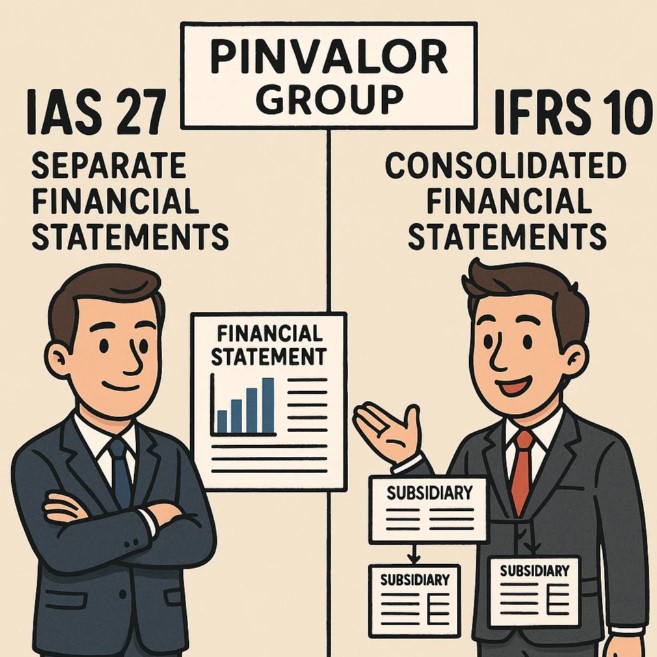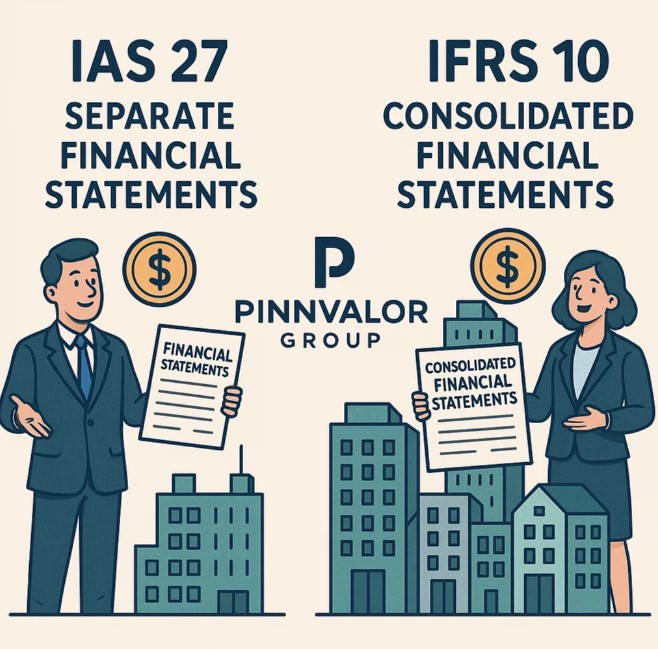
IAS 27 vs IFRS 10: Separate vs Consolidated Financial Statements
In the world of corporate reporting, understanding the distinction between separate and consolidated financial statements is crucial. IAS 27 and IFRS 10 are two major International Financial Reporting Standards that guide how entities present their financials depending on whether they report alone or as a group.
Multinational companies often have complex corporate structures involving subsidiaries, associates, and joint ventures. To maintain transparency and consistency in reporting, IFRS provides two important standards:
Separate or Consolidated – which financial lens gives the clearer picture?
The true financial strength of a company isn't just in its standalone figures. It lies in the power of the group as a whole.
- IAS 27 – Separate Financial Statements
- IFRS 10 – Consolidated Financial Statements
Both standards address different perspectives in financial reporting – one focuses on the individual entity, while the other focuses on the group as a whole.
🌐 IAS 27 – Separate Financial Statements
Purpose:
IAS 27 prescribes the accounting and disclosure requirements for investments in subsidiaries, joint ventures, and associates when an entity prepares separate financial statements.
Key Points:
- Only the parent entity’s own assets, liabilities, equity, income, and expenses are reported.
- Investments in subsidiaries, associates, and joint ventures can be accounted for at:
- Cost
- In accordance with IFRS 9 (Financial Instruments)
- Using the equity method (only if permitted by national GAAP)
- No consolidation procedures are applied.
- Used mostly for legal, statutory, or regulatory filing purposes.
🏢 IFRS 10 – Consolidated Financial Statements
Purpose:
IFRS 10 outlines the principle of control and establishes requirements for the preparation and presentation of consolidated financial statements. It aims to provide a true picture of the economic entity comprised of the parent and its subsidiaries.
Key Points:
- All subsidiaries are consolidated line by line into one set of financial statements.
- Control is defined as:
- Power over the investee
- Exposure to variable returns
- Ability to use that power to affect returns
- Intragroup balances and unrealized profits are eliminated.
- Non-controlling interests (NCI) are shown separately within equity.

📊 Major Differences between IAS 27 and IFRS 10
- Objective: IAS 27 reports only the parent’s financials while IFRS 10 reports the financials of the entire group.
- Consolidation: IAS 27 does not require consolidation; IFRS 10 does.
- Investments: Under IAS 27, investments are shown as a single line item; under IFRS 10, each subsidiary is added line-by-line to the consolidated statements.
- Non-controlling Interest: Not shown under IAS 27 but required under IFRS 10.
- Eliminations: Intra-group transactions are not eliminated in separate statements but are eliminated in consolidated statements.
📝 Practical Example
Suppose Company A owns 100% shares of Company B:
- Under IAS 27: Company A shows its investment in B as a single line in its balance sheet.
- Under IFRS 10: Company A combines all assets, liabilities, income, and expenses of both A and B, and eliminates intercompany transactions.
✅ When to Use Separate vs Consolidated Statements
- Use IAS 27 when separate FS are required for legal/statuary filings, or to analyze the parent company's standalone financial health and dividend-paying capacity.
- Use IFRS 10 when stakeholders need a complete picture of the group’s financial position and performance.
🧾 Conclusion
Both IAS 27 and IFRS 10 have different objectives. IAS 27 focuses on the standalone financial results of the parent company, whereas IFRS 10 provides a holistic view of the group as a single economic entity. Understanding their core differences helps stakeholders interpret financial statements more effectively.
